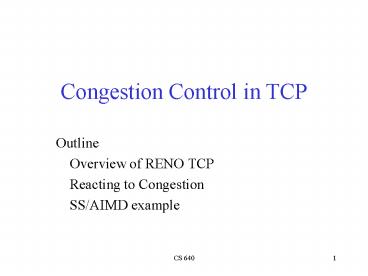Congestion Control in TCP - PowerPoint PPT Presentation
Title:
Congestion Control in TCP
Description:
Congestion Control in TCP Outline Overview of RENO TCP Reacting to Congestion SS/AIMD example CS 640 * CS 640 * TCP Congestion Control Idea assumes best-effort ... – PowerPoint PPT presentation
Number of Views:108
Avg rating:3.0/5.0
Title: Congestion Control in TCP
1
Congestion Control in TCP
- Outline
- Overview of RENO TCP
- Reacting to Congestion
- SS/AIMD example
2
TCP Congestion Control
- Idea
- assumes best-effort network (FIFO or FQ routers)
each source determines network capacity for
itself - uses implicit feedback
- ACKs pace transmission (self-clocking)
- Challenge
- determining the available capacity in the first
place - adjusting to changes in the available capacity
3
TCP RENO Overview
- Standard TCP functions
- Listed in last lecture connections,
reliability, etc. - Jacobson/Karles RTT/RTO calculation
- Slow Start
- Congestion control/management
- Additive Increase/ Multiplicative Decrease (AIMD)
- Fast Retransmit/Fast Recovery
4
Additive Increase/Multiplicative Decrease
- Objective adjust to changes in the available
capacity - New state variable per connection
CongestionWindow - limits how much data source has in transit
- MaxWin MIN(CongestionWindow,
AdvertisedWindow) - EffWin MaxWin - (LastByteSent -
LastByteAcked) - Idea
- increase CongestionWindow when congestion goes
down - decrease CongestionWindow when congestion goes up
5
AIMD (cont)
- Question how does the source determine whether
or not the network is congested? - Answer a timeout occurs
- timeout signals that a packet was lost
- packets are seldom lost due to transmission error
- lost packet implies congestion
- RTO calculation is critical
6
AIMD (cont)
- Algorithm
- increment CongestionWindow by one packet per RTT
(linear increase) - divide CongestionWindow by two whenever a timeout
occurs (multiplicative decrease fast!!) - CongestionWindow always gt 1 MSS
- In practice increment a little for each ACK
- Increment 1/CongestionWindow
- CongestionWindow Increment
- MSS max segment size size of a single packet
7
AIMD (cont)
- Trace sawtooth behavior
8
Slow Start
- Objective determine the available capacity in
the first - Additive increase is too slow
- One additional packet per RTT
- Idea
- begin with CongestionWindow 1 packet
- double CongestionWindow each RTT (increment by 1
packet for each ACK) - This is exponential increase to probe for
available bandwidth - SSTHRESH indicates when to begin additive increase
9
Slow Start contd.
- Exponential growth, but slower than all at once
- Used
- when first starting connection
- when connection goes dead waiting for timeout
- Trace
- Problem lose up to half a CongestionWindows
worth of data
10
SSTHRESH and CWND
- SSTHRESH called CongestionThreshold in book
- Typically set to very large value on connection
setup - Set to one half of CongestionWindow on packet
loss - So, SSTHRESH goes through multiplicative decrease
for each packet loss - If loss is indicated by timeout, set
CongestionWindow 1 - SSTHRESH and CongestionWindow always gt 1 MSS
- After loss, when new data is ACKed, increase CWND
- Manner depends on whether were in slow start or
congestion avoidance
11
Fast Retransmit and Fast Recovery
- Problem coarse-grain TCP timeouts lead to idle
periods - Fast retransmit use 3 duplicate ACKs to trigger
retransmission - Fast recovery start at SSTHRESH and do additive
increase after fast retransmit
12
Fast Retransmit Results
- This is a graph of fast retransmit only
- Avoids some of the timeout losses
- Fast recovery
- skip the slow start phase in this graph at 3.8
and 5.5 sec - go directly to half the last successful
CongestionWindow (ssthresh)































